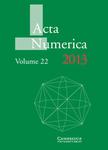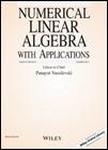版权所有:内蒙古大学图书馆 技术提供:维普资讯• 智图
内蒙古自治区呼和浩特市赛罕区大学西街235号 邮编: 010021
T=题名(书名、题名),A=作者(责任者),K=主题词,P=出版物名称,PU=出版社名称,O=机构(作者单位、学位授予单位、专利申请人),L=中图分类号,C=学科分类号,U=全部字段,Y=年(出版发行年、学位年度、标准发布年)
AND代表“并且”;OR代表“或者”;NOT代表“不包含”;(注意必须大写,运算符两边需空一格)
范例一:(K=图书馆学 OR K=情报学) AND A=范并思 AND Y=1982-2016
范例二:P=计算机应用与软件 AND (U=C++ OR U=Basic) NOT K=Visual AND Y=2011-2016

Julian Code (https://***/EricDarve/numerical_linear_algebra)
numerical linear algebra with Julia provides in-depth coverage of fundamental topics in numerical linear algebra, including how to solve dense and sparse linear systems, compute QR factorizations, compute the eigendecomposition of a matrix, and solve linear systems using iterative methods such as conjugate gradient. Julia computer code is provided along with implementations in Julia that illustrate concepts and allow readers to explore methods on their own.
Written in a friendly and approachable style, the book contains
Julia code to illustrate concepts and allow readers to explore methods on their own,
mathematical foundations and detailed descriptions of algorithms, and
illustrations and graphics that emphasize core concepts and demonstrate the algorithms.

This classic volume covers the fundamentals of two closely related topics: linear systems (linear equations and least-squares) and linear programming (optimizing a linear function subject to linear constraints). For each problem class, stable and efficient numerical algorithms intended for a finite-precision environment are derived and analyzed. While linear algebra and optimization have made huge advances since this book first appeared in 1991, the fundamental principles have not changed.
This book
provides a unified perspective and covers certain topics in a non-standard and interesting form;
includes material that can be difficult to find elsewhere—in particular, techniques for updating the LU factorization, descriptions of the simplex method applied to all-inequality form, and the analysis of what happens when using an approximate inverse to solve Ax=b;
enhances understanding through the inclusion of numerous exercises.
numerical linear algebra and Optimization is primarily a reference for students who want to learn about numerical techniques for solving linear systems and/or linear programming using the simplex method; however, Chapters 6, 7, and 8 can be used as the text for an upper-division course on linear least squares and linear programming.



“A beautifully written textbook offering a distinctive and original treatment.” - Nicholas J. Higham, University of Manchester
“Offers a rarely seen integration of computation and theory, illuminated by judiciously chosen examples.” - Ilse Ipsen, North Carolina State University
“Almost the perfect text to introduce graduate students to the subject.” - Daniel Szyld, Temple University
“An ideal book for a graduate course in numerical linear algebra.” - Suely Oliveira, University of Iowa
电话和邮箱必须正确填写,我们会与您联系确认。
版权所有:内蒙古大学图书馆 技术提供:维普资讯• 智图
内蒙古自治区呼和浩特市赛罕区大学西街235号 邮编: 010021

暂无评论